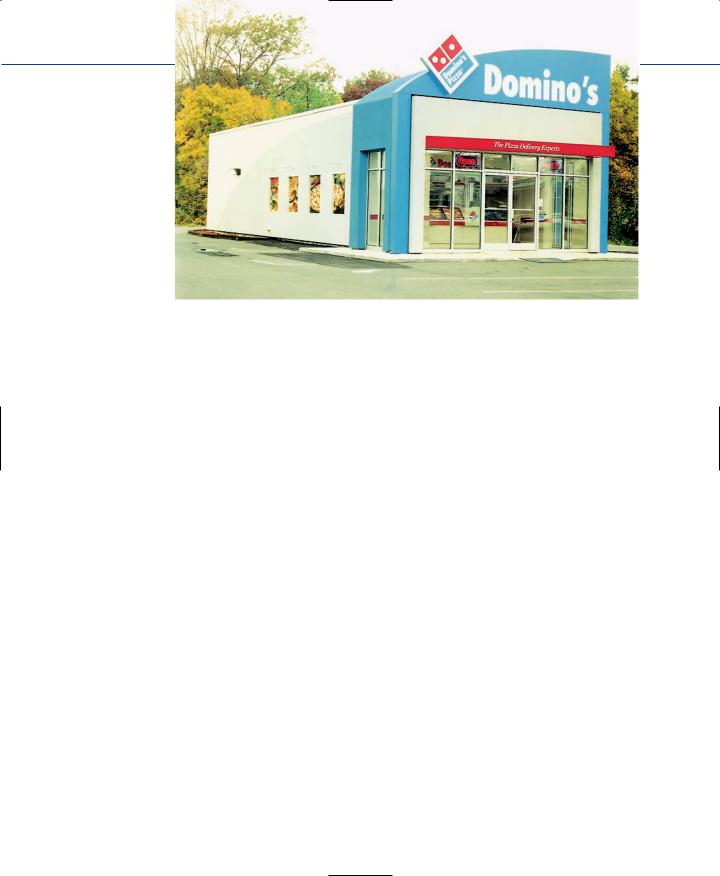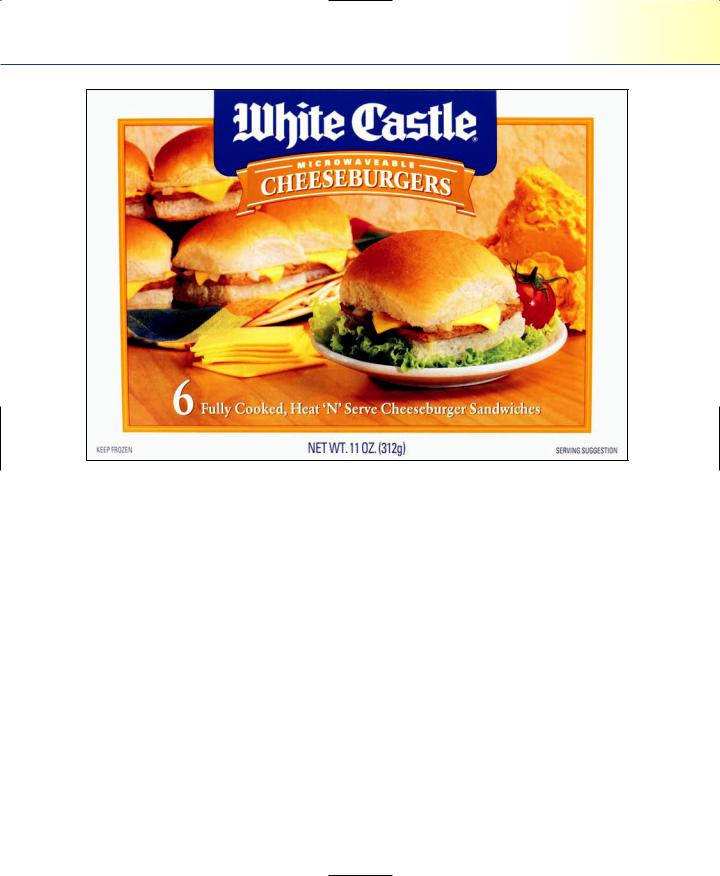
- •CONTENTS
- •PREFACE
- •Content—Benefits for Students
- •Content—Benefits for Instructors
- •Features of the Book for Students and Instructors
- •Supplementary Materials
- •Acknowledgments
- •What Is Hospitality Management?
- •The Manager’s Role in the Hospitality Industry
- •Why Study in a Hospitality Management Program?
- •Planning a Career
- •Employment as an Important Part of Your Education
- •Getting a Job
- •Employment at Graduation
- •The Outlook for Hospitality
- •Summary
- •Managing Change
- •Demand
- •Supply
- •Workforce Diversity
- •The Impact of Labor Scarcity
- •Summary
- •The Varied Field of Food Service
- •The Restaurant Business
- •The Dining Market and the Eating Market
- •Contemporary Popular-Priced Restaurants
- •Restaurants as Part of a Larger Business
- •Summary
- •Restaurant Operations
- •Making a Profit in Food Service Operations
- •Life in the Restaurant Business
- •Summary
- •Chain Restaurant Systems
- •Independent Restaurants
- •Franchised Restaurants
- •Summary
- •Competitive Conditions in Food Service
- •The Marketing Mix
- •Competition with Other Industries
- •Summary
- •Self-Operated Facilities
- •Managed-Services Companies
- •Business and Industry Food Service
- •College and University Food Service
- •Health Care Food Service
- •School and Community Food Service
- •Other Segments
- •Vending
- •Summary
- •Consumer Concerns
- •Food Service and the Environment
- •Technology
- •Summary
- •The Evolution of Lodging
- •Classifications of Hotel Properties
- •Types of Travelers
- •Anticipating Guest Needs in Providing Hospitality Service
- •Service, Service, Service
- •Summary
- •Major Functional Departments
- •The Rooms Side of the House
- •Hotel Food and Beverage Operations
- •Staff and Support Departments
- •Income and Expense Patterns and Control
- •Entry Ports and Careers
- •Summary
- •The Economics of the Hotel Business
- •Dimensions of the Hotel Investment Decision
- •Summary
- •The Conditions of Competition
- •The Marketing Mix in Lodging
- •Product in a Segmented Market
- •Price and Pricing Tactics
- •Place—and Places
- •Promotion: Marketing Communication
- •Summary
- •The Importance of Tourism
- •Travel Trends
- •The Economic Significance of Tourism
- •The United States as an International Tourist Attraction
- •Businesses Serving the Traveler
- •Noneconomic Effects of Tourism
- •Summary
- •Motives and Destinations
- •Mass-Market Tourism
- •Planned Play Environments
- •Casinos and Gaming
- •Urban Entertainment Centers
- •Temporary Attractions: Fairs and Festivals
- •Natural Environments
- •On a Lighter Note. . .
- •Summary
- •Management and Supervision
- •The Economizing Society
- •The Managerial Revolution
- •Management: A Dynamic Force in a Changing Industry
- •What Is Management?
- •Summary
- •Why Study Planning?
- •Planning in Organizations
- •Goal Setting
- •Planning in Operations
- •The Individual Worker as Planner
- •Long-Range Planning Tools
- •Summary
- •Authority: The Cement of Organizations
- •Departmentalization
- •Line and Staff
- •Issues in Organizing
- •Summary
- •Issues in Human-Resources Management
- •Fitting People to Jobs
- •Recruiting
- •Selection and Employment
- •Training
- •Retaining Employees
- •Staff Planning
- •Summary
- •The Importance of Control
- •Control and the “Cybernetic Loop”
- •Tools for Control
- •Summary
- •Leadership as Viewed by Social Scientists
- •Why People Follow
- •Leadership Theories
- •Communication
- •The Elements of Leading and Directing
- •Developing Your Own Leadership Style
- •Summary
- •A Study of Service
- •Rendering Personal Service
- •Managing the Service Transaction
- •How Companies Organize for Service
- •Summary
- •INDEX

162 |
Chapter 6 Competitive Forces in Food Service |
Competitive Conditions in Food Service
Competition in food service has always been intense. There are many buyers and many sellers, a condition that makes it hard for any company to achieve control over the market—that is, over prices and other competitive practices. The nature of the competition, however, has changed from the heady days of the growth of new chain concepts in a rapidly expanding market—roughly from the mid 1950s to the early 1980s—to a time today when established food service giants struggle with each other
over a much more slowly growing market.
During the period in question, the industry grew rapidly. As more women went to work, more families could afford to eat out—and were pressed by time to do so. In spite of intense competition, firms had lots of opportunities in an expanding market.
Moreover, the competition between new chain concepts was largely to fill unmet demand. The challenge was to grow rapidly enough to snap up the available locations in existing territories and expand into new territories ahead of the competition.
Although there was competition between new concepts for both customers and locations, newer operations were competing, to a large extent, principally against outmoded, independent operations for customers’ attention and patronage. It was relatively easy for new, well-advertised, low-priced operations to take business from old, tired units that had high labor costs and usually indifferent, expensive service.
In the 1980s, however, conditions began to change for the chains that had been enjoying success. During the 1970s, it had already become harder to find good locations. Moreover, the marketplace changed from one that was anxious to try a new concept to one already saturated with restaurants constructed during the prior 10 to 15 years. Competition now was more and more between established operations with sophisticated marketing and a proven, accepted operating format. In the hamburger
Many chains are synonymous with well-known brand names. (Courtesy of Tim Horton’s.)

Domino’s is a well-known brand within the pizza segment. (Courtesy of Domino’s Pizza, Inc.)
segment, for instance, competition had gone from Joe’s Diner versus McDonald’s to McDonald’s versus Burger King versus Wendy’s versus Hardee’s—all struggling aggressively for market share. Nevertheless, the industry continued to expand in numbers of units. Between 1985 and 1987, an incredible 40,000 new restaurants opened.
Since those turbulent times, much has changed. Now, one could argue, most of the prime (traditional) locations have indeed been claimed, at least for the quickservice sector. As a result, much of the expansion is targeting international locations and/or “nontraditional” locations—a concept that will be discussed later. Because of these changing conditions, some companies have left the field, become lesser players, or changed their strategies. Marriott, for instance, sold off most of its restaurants and quickservice divisions. Interestingly, at one time Marriott was known exclusively as a food service company. Basically, the reason for these decisions appears to have been limited food service profits in a crowded industry and competitive pressures that were likely only to get worse. The established players had a dominance that even a company as large and accomplished as Marriott could not challenge. Other companies that have come and gone include Howard Johnson’s, which was once a major player in food service with 1,000-odd restaurants. Their last few remaining restaurants in North America have just been closed. The general consensus is that the company was unable to keep up with the times. Further, consider the number of takeovers, mergers, and acquisitions that have occurred over the last ten years and one can quickly see that the food service landscape has changed dramatically.
Although our discussion above (and throughout this chapter) has focused on chain operations, we should note, too, that many independent operations have withdrawn from the market and many of the remaining independents are either very large operations or operators that dominate a small or very specialized market. The independents’ role in food service remains a vital one, but their share of the market has fallen
163

164Chapter 6 Competitive Forces in Food Service
steadily for some years. Success appears to come mainly to those who have a very distinct way of differentiating themselves from their competitors. As well, in the end, many of these same successful independents become successful chain operations.
Heightened competition—and food service firms’ reactions to it—have created a situation sufficiently different that fundamentally new competitive strategies are emerging or have emerged that are changing the face of food service. This leads us to our discussion of something known as marketing. Marketing is not just advertising. Marketing is defined as “communicating to and giving . . . customers what they want, when they want it, where they want it, at a price they are willing to pay.”1 One of the ways that restaurants accomplish this is by a variety of activities known as the marketing mix.
The Marketing Mix
Agood frame of reference for examining these strategic changes is to review what is happening in food service marketing. Marketing is a mix of activities that deals with the four Ps: the product itself, the product’s price, the place (or places) in
which it is offered, and promotion of the product.2 The four Ps are referred to as the marketing mix, and among them, they cover the major areas of competitive activity. The marketing mix is a fundamental tool of analysis, widely used in the hospitality industry. It is important to realize that marketing is a mix of activities. Marketing activities, in the examples that follow, may emphasize one element of the mix, but two or three others are usually involved, either explicitly or implicitly. Case History 6.1 illustrates how one company combines different elements of the marketing mix.
PRODUCT
A useful way of looking at the hospitality product is that it is actually the guest’s experience. In a restaurant, this involves not only the food served but the way the server and guest interact and the atmosphere of the place. This is not to argue that the physical product (food) is unimportant, but it needs to be seen in the context of the overall concept of the operation that determines the guest’s total experience. Our discussion of product will, therefore, cover food products and restaurant concepts.
The importance of good food hardly needs to be discussed. Guests simply assume the food is acceptable. What is acceptable, of course, varies from operation to operation. Wendy’s creates a different product expectation in guests than does the WaldorfAstoria or the Four Seasons. Product acceptability requires that guest expectation be met or exceeded. It is clear that all elements of this service product are essential. A grouchy server or a dirty dining room can spoil the best experience.

CASE HISTORY 6.1
Finding the Proper Marketing Mix—Shakey’s Pizza
Many restaurant goers who grew in the 1960s and 1970s fondly remember Shakey’s Pizza. Traditional pizza, old time movies, and live music kept many young kids and their families entertained and made for a nice family outing. While Shakey’s is no longer represented on the East Coast of the United States, the company is refocusing on the southern California market. They currently have approximately 65 restaurants, primarily in southern California and mostly in greater Los Angeles.
Still firmly entrenched in the pizza/family dining segment of the industry, the company finds itself competing with a different type of competitor than it had earlier in the history of the company. Newer competitors include Chuck E. Cheese and Peter Piper Pizza as well as other family dining restaurants all competing for the same food service dollar. Indications are that they also compete with QSRs for some meal occasions. While the Shakey’s menu has not undergone many changes over the last 25 years, it does contain more than just pizza. Shakey’s continues to offer a family-oriented menu focusing on pizza but also promoting their Mojos®, deep fried breaded potato slices.
In an effort to target families, Shakey’s employs several strategies including targeted advertising (both radio and television), attractive prices, coupons, and direct mail. Their in-store strategies include offering a relaxed dining environment, separate game rooms for children, and a buffet at lunch. Future plans include giving their Web site a facelift and continuing to offer deals over the Internet. They also encourage local store marketing efforts. They are also working on developing new products and ultimately repositioning the brand. The company was founded in Sacramento, California in 1954.
1.The information in this note is based on an interview conducted with Suzi Carragher, Marketing Manager for Shakey’s, on January 2, 2003.
New Products. New products are often a key part of a campaign to revitalize sales in a well-established chain. New products add a note of excitement for customers. Menu enhancement can be a very important tool available to restaurateurs. It should- n’t come as any surprise that menu analysis and development is taught regularly in hospitality management programs.
New products are also used to target new market segments. Some years ago, for instance, Wendy’s noted that it had a mainly male customer base. To target women, Wendy’s introduced the baked potato as a main meal dish and installed salad bars. Both products—salads and baked potatoes—had the effect of increasing Wendy’s market share among women. Interestingly, Taco Bell later introduced its large-portion tacos and burritos to increase its market share among men. Similarly, larger-portion hamburgers have been introduced by numerous chains in recent years (most recently, Carl’s Jr. in the United States and Harvey’s in Canada). McDonald’s began offering a Happy
165

166Chapter 6 Competitive Forces in Food Service
Meal for adults not too long ago, which combines several healthy choice items. Salads and fruit have also become big sellers.
The evidence suggests that a majority of QSR guests are very interested in new products, and this is even truer of guests selecting a full-service restaurant. Although not all products need to be new, it is clear that to achieve and maintain good menu variety, the excitement of new products is required from time to time—and on a regular basis.
The term “new product” can mean a product that is a genuine innovation—that is, a product that has not been served before commercially. These are sometimes referred to as “new-to-world.” Examples are the Egg McMuffin and Chicken McNuggets, products that set off major sales growth for McDonald’s when they were introduced. Other new products, often introduced defensively, are referred to as “new-to-chain” and are essentially an imitation of a successful new product offered by another operator. KFC’s chicken nugget product is an example of this category. KFC introduced it as a defensive measure when McNuggets had made McDonald’s the biggest “chicken chain” in North America.
Many successful new products appear to follow a life cycle similar to that for products in fashion-dominated industries. Figure 6.1 (which depicts the product life cycle) shows new-product sales increasing rapidly during the introduction and growth stages. At the peak of the cycle, total sales of the product are at their highest, largely because everybody is competing to sell it. Many new products can’t maintain consumers’ interest when everybody else is offering the same or similar products. Consumers tire of them as the novelty wears off.
Figure 6.2 also suggests that maturity doesn’t necessarily mean the death of a concept. In fact, most products we all use are at the mature stage of the life cycle, but marketers have learned to spice up an existing product with changes in its marketing
Growth |
Maturity |
Decline |
Introduction
Figure 6.1
The product life cycle.

|
|
The Marketing Mix |
167 |
|
Evolutionary |
|
|
First generation |
period |
Second generation |
|
Concept Expansion |
Maturity |
Concept |
Expansion |
Maturity |
development |
|
redevelopment/ |
|
|
|
|
rejuvenation |
|
|
|
|
Time |
|
|
Figure 6.2
Restaurant concept life cycle. (Source: Adapted from Technomic Consultants.)
mix. This is true not just of individual products but also of entire concepts. Products can be reinvented, repackaged or their appearance otherwise changed.
When a concept goes unchanged too long, it does become dated. The Howard Johnson’s chain was mentioned earlier in the chapter. The Chi Chi’s chain presents another study. Chi Chi’s was one of the first chains to offer casual dining as the heart of its concept. That concept, however, remained essentially unchanged for 21 years. As a result, Chi Chi’s had several years of declining sales, but in 1997, the chain began working to bring restaurant decor and menu design up-to-date—and supported these product changes with a new advertising campaign. Eventually, Chi Chi’s went on to win awards for its food quality and menu variety, including Restaurant and Institution’s
Choice in Chains for the Mexican category. In short, they were able to make the necessary changes to turn the company around. The chain has since closed, its units having been purchased by Outback in 2004—the closing being caused by an outbreak of foodborne illness in one of their restaurants which led to subsequent bankruptcy. Another casual chain, Chili’s, responded to decreasing sales by changing 60 percent of its menu items and adding 24 new products to its menu. By the end of 1997, Chili’s sales had gone from a decline to nearly a 6 percent increase. By 1998, the same chain was experiencing double-digit growth. Although much of the improvement came from

168Chapter 6 Competitive Forces in Food Service
stronger pricing, customer traffic increased 1.5 percent in spite of higher prices. More recently, Brinker International (the parent company of Chili’s) has grown revenues every year since 2000.
Addition of services and changes in decor can also be crucial in the competitive struggle. Drive-through restaurants found themselves trapped in price-oriented, 99-cent “sandwich wars.” Two of the leaders in that segment decided to sidestep this no-win strategic trap by changing the concept (i.e., product) and adding indoor seating. Although conversion costs were as high as $200,000 per store, increased traffic counts, sales, and profits justified this move. Others have focused on improving drive-through services. With some basic changes in delivery, McDonald’s recently reduced the drivethrough time for customers by 40 seconds.3
Typically, new menu items are introduced to improve sales and/or help to differentiate the restaurant and its menu. Two West Coast chains, Jack in the Box and Carl’s Jr., saw an opportunity to increase sales where both of them had a weak day part, at breakfast. Jack in the Box introduced “combo meals,” which bundled several products in an attractively priced package. Jack in the Box has since reformulated some of their burger items and also reintroduced some Mexican items as well. Carl’s Jr. introduced a proven breakfast menu from Hardee’s, a chain owned by CKE, Carl’s Jr.’s parent. In each of the preceding cases, the company sought to rejuvenate its concept to achieve the rebound depicted in Figure 6.2. Wendy’s recent introduction of a new salad line was immediately successful and contributed greatly to increased profitability in the year they were introduced.
Extension of Concept. In some ways, food service companies are changing the nature of their product by seeking to serve entirely new markets through concept extension. This may ultimately change the way the public perceives them, but thus far, it has resulted in increased sales. Quick-service food products, for instance, are increasingly turning up in in-flight meals. Quick-service chains are partnering with gasoline companies, offering food service along the highway in gas stations. Cafeteria chains, such as Piccadilly, are partnering with supermarkets. In addition, many food service companies are packaging their product for distribution through retail stores. Taco Bell, for instance, has sold the rights to its brand name and entered into partnership with food manufacturers that will handle development of the manufactured product and its distribution. Growing customer demand for Chef Paul Prudhomme’s spices finally led him to develop a line of packaged seasonings, which are now available nationally. Other famous food service names associated with retail products are as varied as White Castle, Wolfgang Puck, UNO Chicago Grill, and Starbucks.
A development that is in the forefront of concept extension is the introduction of downsized units with limited versions of a franchise brand’s menu. These seem to be

The Marketing Mix |
169 |
White Castle offers their hamburgers for sale in retail outlets. (Courtesy of (© White Castle System, Inc. All rights reserved.)
popping up everywhere, in carts or other portable units. We will return to this topic when we discuss place later in this chapter.
Branding. Branding is considered a product characteristic because the brand is used to heighten awareness of the product in the consumer’s mind. The uses of branding in food service are on the increase today, and industry practice is highly varied. It can involve branding of individual menu items, as with the Big Mac, to give them greater prominence, or it can involve using a manufacturer’s name on an operation’s menu, such as Coke in a QSR. In short, it can occur in a variety of ways but with the ultimate objective of promoting the product by leveraging the brand name.
Sometimes it is not just one product but an entire concept that is adopted in a joint location. Miami Subs needed a way to strengthen its weak day parts. Rather than invent and promote a new product of its own, the company added Baskin-Robbins ice cream and frozen yogurt, which sold well in the otherwise slow late-afternoon and late-evening day parts. Other companies have reached similar arrangements, including Baskin-Rob- bins and Subway, and Wendy’s and Tim Horton’s (owned by the same company).

170 |
Chapter 6 Competitive Forces in Food Service |
A brand name helps to heighten the guest’s awareness of the product. (Courtesy of Rainforest Café.)
Finally, product improvements can center around more tightly controlled operations. Quick-service leader McDonald’s sought to fight falling sales volume with improvements to existing products, resolving to stop microwaving sandwiches and reintroduced toasted buns for its sandwiches. It continues to add new products and revamp existing ones. New products were also being planned to liven McDonald’s familiar menu. At the same time, another familiar name, Pizza Hut, continues to roll out new items including pasta dishes and different types of pizzas such as Chicago-style deep dish.
PRICE
The restaurant industry was reminded of the power of price competition by Taco Bell in the mid-1980s when experiments with lower prices proved so successful that they were adopted as a major strategy of the company. Value pricing, as it came to be called, drove sales increases of 60 percent over a three-year period. Some of the hazards of leading with price came home to roost roughly ten years later. John Martin, widely recognized as one of the most talented restaurant executives of a generation, after a ten-year run of value pricing, was replaced as president of Taco Bell. Not long thereafter, Taco Bell was reported to be shifting away from low prices and upgrading to higher quality with higher prices in a move code-named “Project Gold.”

The Marketing Mix |
171 |
The problem with value pricing proved to be that eventually competitors adopted new pricing strategies to counter it. Then what was left was a lower profit margin for everyone.
One way of effectively reducing prices temporarily is by offering coupons that entitle the bearer to a special discount, a practice called couponing. Although this does affect price, it is generally treated as a promotional tactic, and so we will treat it under that topic later in the chapter. We should note here, however, that couponing and other price-cutting tactics are sometimes likened to an addiction. It is easy, even pleasant, to start. Sales go up; customers are happy with a bargain; with rising sales, things look brighter for the operation. At the end of a prolonged period of discounting, however, the favorable impact on sales is usually eroded. Moreover, profit margins decrease immediately unless the increase in customer traffic offsets the price reduction. Direct, noticeable competition on price in food service occurs, but it is the exception rather than the rule just because its result is generally to depress everyone’s margins. Price competition is most common in the off months (usually January through March), when market leaders seek to maintain volume at or above break-even levels at the expense of their smaller competitors.
There is a risk in price reductions, namely, that the lower price will denote a cheapened product to the customer. On the other hand, in the late 1980s and early 1990s, many fine-dining establishments rewrote their menus when customers rebelled against upscale operations with very high menu prices. The new menus featured foods that had a lower food cost and, hence, could be offered at an attractive price. This led to a turnaround for many of these operations. As with virtually all marketing activities, the key is to keep prices in line with customer expectations and to offer products that are perceived to be a good value to the customer.
Pricing: Strategic Implications. Pressure on prices, we should note, has implications for other elements of the marketing mix. A period of rising prices can mean a favorable climate for competition through innovation. The cost of upgraded decor, new product development, more extensive preparation equipment, and more preparation labor all could be passed on to the consumer in higher prices. In the future, however, the test for innovation may be stiffer. Changes will have to create savings or major increases in sales volume. If innovations don’t pass these stricter tests, they may have to be dropped, because their cost cannot be passed on in ever-higher prices.
PLACE—AND PLACES
In marketing, place refers to the location, the place where the good or service is offered. The great hotelier Ellsworth Statler said of hotels that the three most important

A good location is an important element of marketing. (Courtesy of Domino’s Pizza, Inc.)
factors in success are “location, location, and location.” This has often been repeated regarding many other retailers and is certainly true of food service.
Food service chains are now concerned, however, not just with place but with places. They are seeking to achieve wide distribution of their product and so are developing tactics to multiply the number of places in which their product—or some version of it—can be offered.
Indeed, one of the most dramatic changes since the introduction of quick service is now under way as multiunit companies continue to change their strategy regarding location. Companies now try to “capture” customers wherever they might be.
Today’s customers live harried and hurried lives. Whether members of a two- working-spouse family or a single-parent family, adults (and, increasingly, children) today see themselves as being constantly rushed. The tendency is to fit meals in wherever they happen to be, to “grab a bite,” as the phrase has it, “on the run.” Effective distribution, then, is achieved by locating an outlet wherever consumers might go in any numbers.
Restaurant companies have developed downsized units for places where a traditional unit won’t fit. These units often take the form of a kiosk or mobile cart requiring minimal investment. The name given these new units is points of distribution (PODs).
As an example, the Little Caesars pizza chain, in its partnership with Kmart, has downsized Pizza Express units in many Kmart stores. Other companies that have adopted similar strategies include Piccadilly Cafeterias, with their Piccadilly Express lines. Even companies such as Cheesecake Factory, Applebee’s and California Pizza Kitchen have developed smaller prototypes for purposes of meeting space restrictions in mall settings and the like.4
172

The Marketing Mix |
173 |
In the language marketers have developed to talk about PODs, a host is any establishment, such as Kmart, where high traffic is likely to offer potential high-volume sales. Examples include retail operations, malls, colleges, airports, manufacturing plants, or theme parks. The host offers a food service operator access to the host’s traffic. The advantage to the host is that its establishment is enhanced by the additional service; the food service company, on the other hand, gets increased access to customers and sales. Host locations are referred to as venues. A venue includes not only a place but assurance of a particular kind of traffic associated with the location, such as shoppers, students, or office workers. A&W has capitalized on locating units in shopping malls and has been quite successful in doing so.
The expansion of food service chains via PODs has stirred considerable controversy. Other franchisees are concerned that the downsized units will dilute brand image, threaten quality, and create competition for existing franchisees. Some franchisees are against it, believing that sales from POD operations cannibalize sales from existing, full-size stores. Other companies have ventured into introducing express units at the behest of its franchisees, such as with Tony Roma’s. This is one of the issues that franchisors and franchisees continue to communicate about.
The expansion of downsized units is not just limited to QSRs. Casual restaurants, including independents, have jumped on the bandwagon of multiplying the places where their food service is offered, often in downsized units with restricted menus. What PODs of all kinds offer the consumer is an advantage highly valued in this fastpaced, hurried age: the convenience of a handy location.
Contract companies have become franchisees of restaurant companies and have also developed their own proprietary brands, such as ARAMARK’s Itza Pizza. Restaurant companies now find that they face competition from contract companies that have begun to operate units in retail stores and malls. Contract companies, on the other hand, face competition from restaurant companies in the on-site market. Restaurant companies are franchising “hosts” to operate units as part of their own food service operation. For instance, Subway Express units are springing up on campuses; Baskin-Robbins kiosks and carts are found not only on campuses but also in hospitals, factories, airports, and tollway plazas. Pizza Hut, too, delivers its product for resale in institutions such as hospitals and schools.
PROMOTION
Two major forms of paid promotional activities (or marketing communication, as it is often called) are advertising and sales promotion.5 We will discuss each briefly. Fullservice restaurants (with check averages of $15 to $24.99) spend 1.8 percent of sales on marketing, whereas QSRs spend 0.6 percent.6

174Chapter 6 Competitive Forces in Food Service
Advertising. Advertising is used as part of a long-term communications strategy and is often intended to create or burnish an image. The food service industry is one of the largest advertisers in the United States; McDonald’s alone spent over $1.6 billion on total advertising spending in 2005.7 The entire industry spends just over $5 billion annually. Advertising campaigns are generally made up of many different ads and commercials tied together by some common theme. In late 2003, McDonald’s announced a campaign whose platform for new ads uses the slogan “I’m lovin’ it.TM” The campaign is designed to send a single message to consumers of all ages and geographic locations—it is being aired in 12 different languages. All the commercials in this campaign follow a theme depicting different life styles and cultures.8
As media become more crowded, themes come and go and are adapted depending on consumer reaction. However, one thing that stands out clearly is the very generous spending on advertising by the larger companies. For instance, in introducing a new dual-patty product, the Big King, Burger King budgeted $30 million. It is important to remember that advertising takes many forms—not just televison advertising. In fact, many successful restaurant chains do no television advertising at all—including Mimi’s and Houston’s. Advertising may also be conducted through radio, billboards, newspapers, magazines, and the like.
Responding to a Diverse Market. To reach a diverse market, specialized advertising directed at particular ethnic markets is becoming common practice. Both advertising agencies and specialized media have evolved to reach Hispanic and African American consumers, who had $581 billion and $646 billion, respectively, in discretionary income in 2002.9 Consumer markets can also be segmented by income and wealth. Industry Practice Note 6.1 discusses some characteristics of the weathiest consumers.
The most common media for mass communication in food service are the electronic and print media, billboards, and direct mail. Figure 6.3 shows the breakdown of the major components of each and characteristics frequently associated with each.
The Internet in Food Service Promotion. A newer medium for restaurant advertising is the Internet. Although the use of the Internet in food service marketing is still in its infancy, there are plenty of examples available to illustrate the direction in which the industry is moving. Home pages on the World Wide Web are used primarily as sources of information and to provide links to e-mail addresses. Online service providers such as America Online (AOL) and CompuServe feature information about and for food service professionals. The use of the Internet as a marketing tool is growing by leaps and bounds as this is being written but seems to still be underutilized. A recent study by the National Restaurant Association indicates that just one-half of the

INDUSTRY PRACTICE NOTE 6.1
The Wealthiest Consumers
The term “wealthy” can be defined in many different ways—by annual income, by amount of discretionary income, or by highest net worth (total wealth). In a report by American Demographics magazine, this group is defined by those households that have a total net worth of $2 million or more. This group represents just 2 percent of all U.S. households. Either way that wealth is defined, this group behaves differently, engages in different recreational activities, and makes different purchases than the rest of the country. They also attract the attention of the media and other groups that track their spending habits. Among other things, American Demographics concludes that:
■The highest percentage of wealthy households are in the Northeastern United States and the West Coast.
■Almost three-fourths have a university degree or higher.
■Most heads of these households are still working.
■Many consumers within this group shy away from media based advertising.1
The number of companies and organizations that target this group is growing. The American Affluence Research Center tracks America’s wealthiest 10 percent in “provide[ing] reliable marketing and economic information about the values, lifestyles, attitudes, and purchasing behavior of America’s most affluent consumers.” Mendelsohn Media Research produces an annual survey of demographic information and spending of households earning $75,000 or more. And The Rich Register publishes an annual directory of the wealthy. It includes information on almost 5,000 of the richest Americans (with a net worth of $25 million or more).
According to the U.S. Census Bureau’s Consumer Expenditure survey, the wealthiest consumers spend 50 percent more on food away from home than the next category of consumers (categorized by annual income).2 For this reason and others, marketers segment and target this select group of consumers. As a result of recent difficulties in the stock market, research indicates that affluent Americans, as a group, report that they expect to spend less in both casual and upscale restaurants in the near term.3
Sources:
1.Bureau of Labor Statistics, Consumer Expenditure Survey (2001).
2.Alison Stein Wellner and John Fetto, American Demographics, “Worth a Closer Look.” June, 2003.
3.American Express, Briefing, September/October 2003.
restaurant operators surveyed indicated that they had a Web site. On the other hand, as the average check increases, the likelihood that the restaurant has a Web site also increases. The most common type of information providied on Web sites is menu listings, general restaurant information, and restaurant locations.10 It should be noted that the industry, as a whole, has not been as progressive in its use of the Internet as some
175

176 |
Chapter 6 Competitive Forces in Food Service |
M E D I U M |
T H E M A R K E T I N G M I X |
B R O A D C A S T M E D I A : |
C H A R A C T E R I S T I C S |
Television |
Large audience, low cost per viewer but |
|
high total cost. |
|
Combines sight, motion, and sound. |
Radio |
Highly targetable, lower cost than TV. |
Cable TV |
Highly targetable, fragmented market. |
P R I N T M E D I A |
|
Newspapers |
Limited targeting possible. Printed word is |
|
regarded as credible by many. |
Magazines |
Targetable, generally prestigious, high- |
|
quality reproduction of photos. |
ROADSIDE |
Excellent for directions. Message limited |
|
to about eight words. |
DIRECT MEDIA |
Excellent targeting but costly per prospect |
|
reached. Good coupon distribution vehicle. |
Figure 6.3
Advertising media and their characteristics.
would like. The magazine Hospitality Technology tracks Internet usage in the industry. According to its editor, Reid Paul, “While nearly every industry in the United States has recognized the power and importance of the Internet and developed online strategies, restaurants lag well behind, largely because there were few recognized opportunities for e-commerce.”11 The magazine supports an annual study of Internet usage in the industry, led by University of Delaware professor, Cihan Cobanoglu. The study evaluates restaurant Web sites on a variety of criteria including technical specifications, technology used, ease of navigation, ease of contact, marketing effectiveness, e-commerce solutions, and legal compliance. The 2006 study found many restaurant Web sites to be lacking although some, including those of Bahama Breeze, Subway, and Legal Sea Foods, scored at the top of the study. Cobanoglu suggests that restaurants make a greater effort to reduce errors in the content, update Web sites more regularly and, most importantly, improve ease of navigation.12
Sales Promotion. Sales promotion consists of activities other than advertising that are directed at gaining immediate patronage. The most common forms of sales promotion
